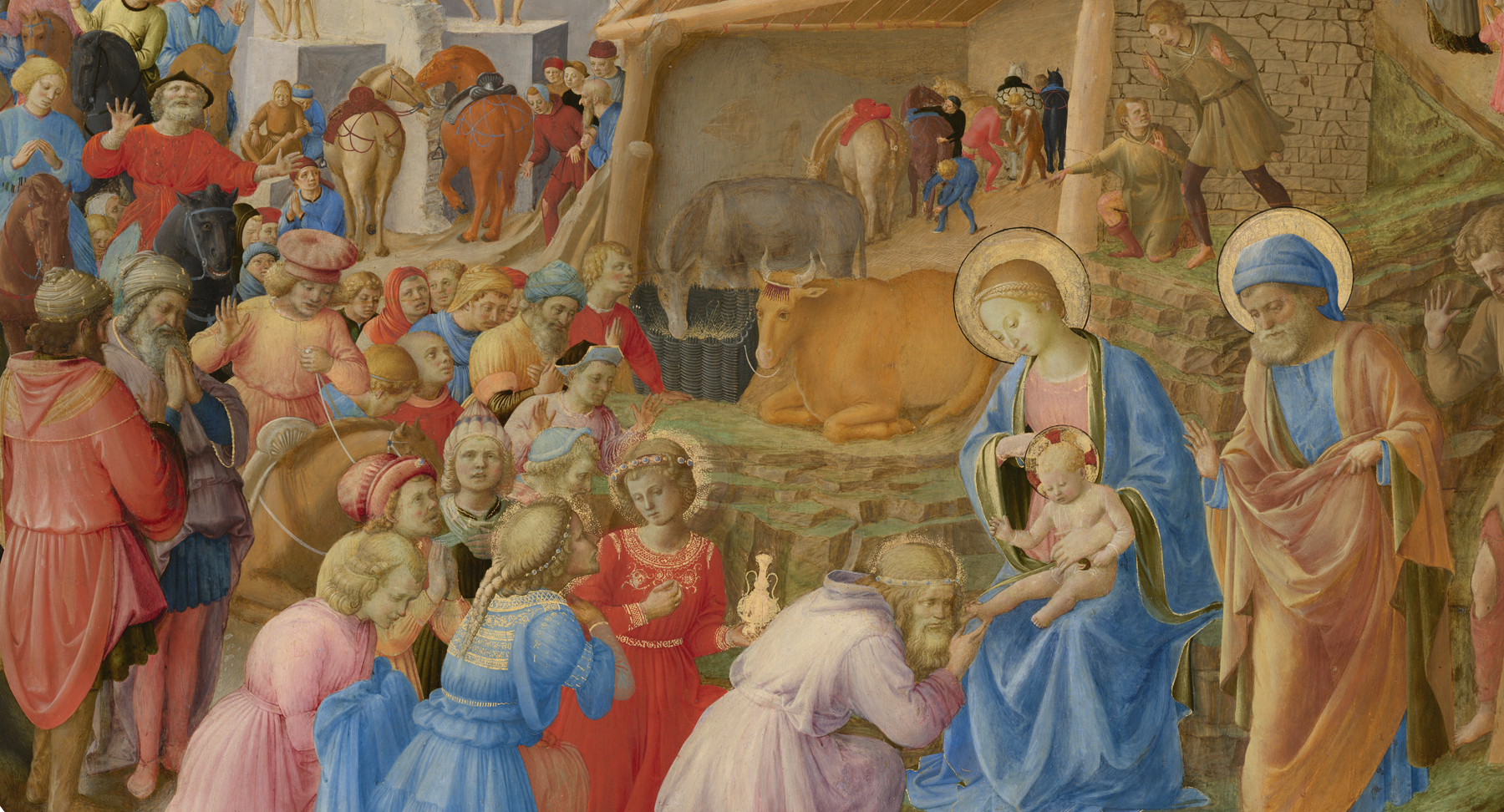It’s easy to feel overwhelmed standing in front of Fra Angelico and Fra Filippo Lippi’s The Adoration of the Magi. The giant circular painting is full of details that might distract your eye from the main event: the story from the Christian Bible in which the Three Kings (magi) meet the Virgin Mary, Christ Child, and Joseph.
First there are the animals: a donkey, cow, horses, peacock, pheasant, and a peculiar-looking white dog. Then there’s the procession of figures winding around the landscape. More than 100 people fill the painting, each with their own expression and dress.
Join us on a journey through some of the most important and unusual details in the painting. Discover a hidden couple of camels and find the fruit that may remind you of a popular arcade game.

Fra Angelico and Fra Filippo Lippi, The Adoration of the Magi, c. 1440/1460, tempera on poplar panel, Samuel H. Kress Collection, 1952.2.2
Who was it made for?
We believe that the Medici family, who ruled Florence, paid for this painting. The Medici were part of a lay confraternity—a religious organization whose members weren’t clergy—called the Compagnia de’ Magi. This group organized an annual festival celebrating Epiphany, the moment when the North Star led the Three Kings to the Christ Child. Great patrons of art, the Medici paid for several paintings that show this scene.
Cosimo de’ Medici probably commissioned Fra Angelico to make this one. The artist was a Dominican friar (monk) who lived in Florence’s church of San Marco. He likely began the painting and laid out its design. After Angelico died in 1455, his rival Fra Filippo Lippi probably completed it.
What is going on?
-
The Three Kings kneel in front of Mary and Christ. Each has a gold-flecked halo.
/
-
One king touches the baby’s toes. Another, dressed in red, holds a gold object. The kings brought the infant Jesus gifts of gold as well as frankincense and myrrh (both resins).
/
-
The kings wear different colors and styles of dress, all decorated with delicate gold details.
The decoration of the red dress may connect to the Medici—ostrich feathers were one of their family emblems.
/
-
According to the biblical story, the kings came from the East. The dress and hats of the figures in the procession are meant to suggest that they are from the Muslim world and Asia.
/
-
However, almost all the people in the painting have light skin and blonde hair—the ideal of beauty in Florence at the time.
/
-
The procession may reference the festival parade of the Compagnia de’ Magi.
/
-
You’ll notice that many of the people have their hands raised or clasped in prayer. These gestures indicate awe at the miracle they were witnessing.
/
-
The procession continues under a crumbling white stone arch.
/
-
Five figures stand on its base, nude or almost nude. They may represent the ancient pagan religions that ended with the arrival of Christ and Christianity.
/
-
We don’t understand every detail of this painting. For example, notice the monk sitting cross-legged. A man in a blue dress rests his cheek on the monk’s back. We're not sure what they're doing.
/
-
The crowd stretches all the way through the mountainous landscape from the upper right of the painting.
/
-
Look closely and you can see a couple of camels in line!
/
What about the peacock on the roof?
At first glance, the stone wall and thatched roof structure might have suggested that this is a Nativity scene (depicting the birth of Christ). But artists in the Italian Renaissance sometimes merged the imagery of the Nativity and Adoration, straying from the biblical text.
-
A peacock perches on the top of the stable. In Christianity, the bird represented paradise or immortality (the animal’s skin was believed to be everlasting).
/
-
To the right, a bird of prey attacks a pheasant. We’re not sure exactly what meaning the pair were meant to convey. Fra Filippo Lippi likely added the three birds after the rest of the painting was finished.
/
-
An adorable donkey and cow duo rest in front of the manger.
/
-
Those aren’t bangs on the cow—they are part of a harness that goes around its horns. The harness both tethers the animal and keeps flies out of its eyes.
/
-
The donkey leans into a basket to munch on some hay.
/
-
Inside the stable, people are busy grooming the horses and even cleaning out their hooves.
/
-
To the left of the stable, a group is engaged in conversation. The tattered pants of one figure may suggest that these are shepherds.
/
-
Two men on the other side of the stable may represent the shepherds present at Christ’s birth.
/
-
Speaking of Christ, what is that round object in his lap?
/
-
It may look like Pac Man, but it is actually thought to be a pomegranate. The fruit’s many seeds represented many believers joined by one faith.
/
-
Lastly, did you spot the white dog lying in the meadow?
/
-
He may be a symbol of loyalty. Or he could be a later addition requested by one of Cosimo’s descendants. The dog has clipped ears, a custom for hunting dogs in the Renaissance.
/
This painting is believed to be the one recorded in a 1492 inventory of Lorenzo de’ Medici’s estate. The inventory lists it as the most valuable painting in his collection. Today, it is one of the greatest Florentine Renaissance paintings in the world.
